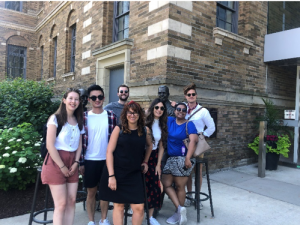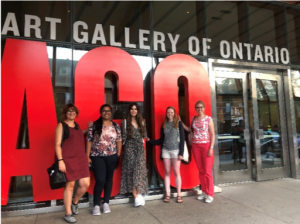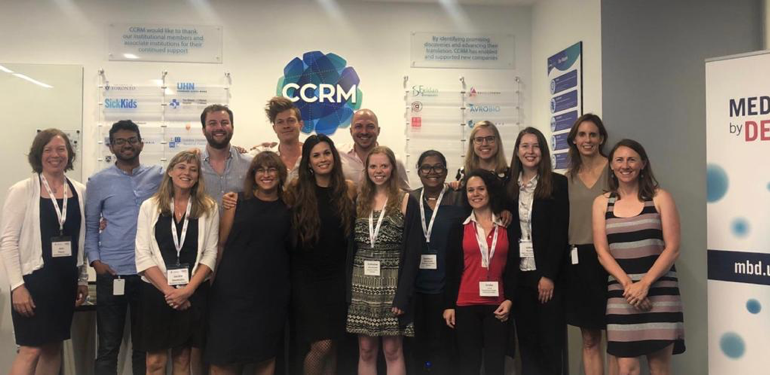Virginia Palomares Cabeza is a fourth-year PhD candidate at the Erasmus Medical Centre (Rotterdam, the Netherlands) and the University College Dublin (Ireland). Her interdisciplinary research focuses on investigating the immune responses of allogeneic stem cell implants for bone regeneration. Virginia is passionate about bringing together different scientific disciplines and improving science communication. Outside of the lab, you can find her acting, traveling or playing board games.

Some of the Summer by Design students, outside the MaRS Centre on College Street in Toronto
It is a truth universally acknowledged for every PhD candidate in science that, as the end of your degree approaches, the terrifying question “what next?” will start to pop up in your head more frequently than you would like it to. Considering a transition from academia to industry (or vice versa) is not always an easy choice to make, but if you feel you’re stuck in the middle and can’t seem to decide, you have to know there are options that allow for getting the best of both worlds.
As a PhD candidate in a project that combines several off-the-shelf approaches in regenerative medicine, transplantation and immunology, I knew I would not have an immediate answer to this question. In fact, I felt I could find a lot of information about science-related job positions in both academia and industry, but I deeply wondered about the path that connected them. How does it work in reality to move your scientific research from bench to bedside? I was not entirely sure.
That’s why, when I first heard of the Summer by Design (SbD) opportunity organized by the University of Toronto’s Medicine by Design, in partnership with CCRM and the Rotman School of Management, I did not hesitate a moment to apply. SbD is an annual summer workshop in Toronto (Canada) that brings together PhD and post-doctoral candidates from all over the world who are interested in connecting the translation and commercialization of regenerative medicine. It sounded like a great opportunity to fill the gap I was missing and several months later I was excited to land in Toronto, ready to start the program.
From the very beginning, the organizers did their best to make us feel at ease, something I highly appreciated. We started learning from scratch about the process of commercializing scientific discoveries in terms of the economic and regulatory perspectives, taking into account the manufacturing process and the potential risks and benefits in the early stages of investing.
By the end of the first week, we had a general understanding of these areas and we were able to dive in to the stages of marketing and intellectual property, and we discussed relevant case studies of big and small companies in the industry. Moreover, we were able to listen to and ask questions of many different people in the Toronto regenerative medicine ecosystem and former SbD participants. I was utterly astonished to learn how many switches these people had made throughout their careers until they found their true vocations, and some had even built up their own companies, from scratch, years after graduating!
One valuable exercise offered by SbD was to be part of several group and individual training sessions to learn how to pitch your science. The aim was to learn to deliver our research in a 5-minute pitch to attract potential investors. If you are (like most of us) a scientist who has never done this before, adapting your scientific content for a general, possibly non-scientific audience, and taking into account potential risks, finances and an exit plan, can be challenging. However, the guidance of the trainers made it a fun and rewarding competition and an overall exciting experience.

Exploring some of Toronto’s attractions, including the Art Gallery of Ontario
I cannot forget to mention the social component of the program, which included a city tour, a visit to the Art Gallery of Ontario, and a pub night hosted by CCRM. The social elements allowed us to explore the city and bond with each other. Moreover, Toronto has a varied food and cultural panorama that satisfies all tastes, and there’s lots of nature to explore within the city and close by (Niagara Falls for example). We enjoyed exploring all that Toronto has to offer during the free time provided in the program.
I started this workshop excited to expand my very limited knowledge of scientific career options and the practical road that leads to the commercialization of research. Some people think being a scientist involves strictly lab-based work either in academia or in the private sector, but I discovered that, in reality, there is a huge spectrum of possibilities in between. This course has also made me aware of the importance for every scientist to be well informed about the steps to take to transform their research idea into a successfully commercialized product, and this starts from the very first steps of the experimental design.
Altogether, I would encourage all young scientists interested in translational regenerative medicine to apply for SbD. And remember, it is never too late (or too early) to start pondering all the options if you are curious about a career switch!

2019 Summer by Design participants and organizers
Guest
Latest posts by Guest (see all)
- Regenerative immunotherapy: Hope for chronic autoimmune diseases - September 16, 2025
- Canada’s regenerative revolution: Why AI is the catalyst - September 4, 2025
- Summer by Design: A launchpad for future entrepreneurs and industry scientists - August 14, 2025






Comments